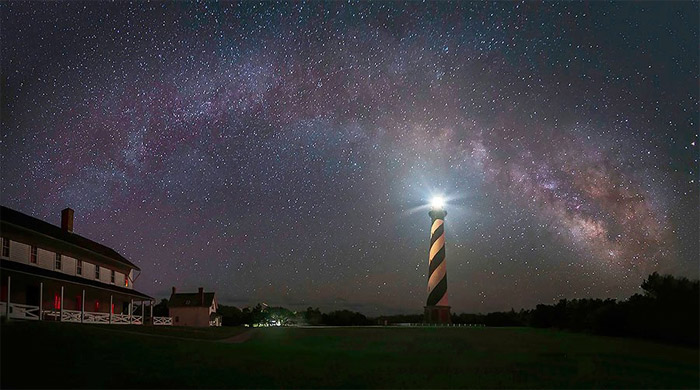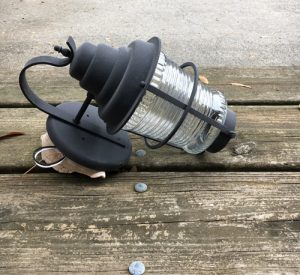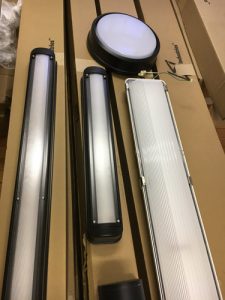
Back in 2016, when the National Park Service was celebrating its 100-year anniversary, our own local Cape Hatteras National Seashore (CHNS) was orchestrating several initiatives to mark the Centennial Celebration, which included taking the initial steps to designate CHNS as an official “International Dark Sky Park,” or IDSP.
This designation is made by the International Dark Sky Association, a non-profit group based in Arizona which established the International Dark Sky Places conservation program in 2001. A dark sky park is defined as a park that has “exceptional starry skies,” where light pollution is minimized, and where a natural dark environment is prevalent.
But obtaining this designation is an undertaking, and it’s a hard feat to achieve.
There are only 67 sites in the world that have earned this designation.
In America, there are roughly 20 National Parks or National Monuments that are in the International Dark Sky Places Program, and only one other park in the state of North Carolina that is recognized as an IDSP – the Blue Ridge Star Park.
The initiative to add CHNS to the list technically began around 2015, as the initial step entails taking an inventory of the current lighting within the park, and identifying lights that need to be retro-fitted and updated. Considering that there are literally hundreds of lights within our National Seashore facilities alone – from the lighthouses, to public restrooms, to the NPS campgrounds – this was no small project, and the expense involved in replacing these light fixtures was certainly an issue that needed to be addressed.
After the announcement in 2016 that the CHNS was looking into an IDSP designation, and after the first inventory steps were completed, news on the undertaking faded in the following years.

That is, until recently.
At the 2018 Year in Review Presentation hosted by the National Park Service on March 28, National Parks of Eastern North Carolina Superintendent David Hallac announced that there was good news on the dark skies front.
The Cape Hatteras National Seashore recently entered a NPS contest to garner the funds required to have the park’s lights retro-fitted, and to move closer to earning the IDSP designation. Competing against parks all across the country, Hallac announced that the Cape Hatteras National Seashore did indeed win the award, and the light replacement project will begin in the summer of 2019.
“We just selected the final light fixture for five historic buildings within Cape Hatteras National Seashore. As part of this project, we will install 175 new fixtures in 31 locations within the park,” said Frank Hester, Engineering Technician for the NPS in an emailed statement. “…We are hoping to start this project this month.”
Once the lights have been switched out, an application can be sent to the International Dark Sky Association for the designation. “They will review the application, and if we pass, they will certify us as a dark sky park,” said Hallac at the March 28 presentation.
So will CHNS be an official International Dark Sky Park in the months to come? It’s hard to say for certain, but the new lighting fixtures are certainly a step in the right direction.
You can read about all of the minimum eligibility requirements for becoming a Dark Sky Park here, but suffice it to say, it’s a pretty lengthy list.
For example, per the IDSP guidelines, typical nighttime conditions characterizing the site in question must be consistent with or exceed the following criteria:

A) The Milky Way is readily visible to the unaided eye;
B) There are no nearby artificial light sources yielding significant glare; and
C) Any light domes present are dim, restricted in extent, and close to the horizon”
As for the park management itself, the park needs to demonstrate its commitment to dark skies and quality outdoor lighting via a number of additional steps, which includes public education, identifying current and future threats to dark skies within the park, and ensuring “at least two-thirds (67%) of existing outdoor lighting fixtures within Park boundaries conform to the Park’s Light Management Plan at the time of IDSP application.”
The Program Guidelines is effectively 19 pages long, so there’s a lot of work to be done before, during, and after a potential IDSP designation.
The good news is that once the new lighting fixtures are installed, the National Seashore itself will have many if not all of the eligibility pieces in place to move forward with the application.
The bad news is that there is still the question of privately owned businesses and residences within the park itself, and whether this will have an impact on our dark skies.
“There’s still some progress to be done there,” said Hallac.
The impact of homes and businesses when it comes to light pollution certainly isn’t a new topic for Hatteras and Ocracoke islands.
Every summer or so, we hear about a sea turtle hatching gone awry when the baby sea turtles are confused by the bright lights of an oceanfront home, and make a mad dash towards a swimming pool or a back porch, mistaking it for the natural nighttime lights off the ocean.
The Island Free Press’ Irene Nolan also wrote a fantastic blog about this subject back in 2014, when she outlined the ongoing theft of the pure night skies.
“…it’s unnecessary. Unnecessary and uneconomical and unwise,” she wrote.

“We’re all to blame. Businesses aim spotlights up from the ground to illuminate their signs, but they light up the heavens as well. Homeowners add security lights to their residences, but they light up the night as well. Visitors turn on porch lights, pool lights, and spotlights at all hours, but they light up the neighborhood as well — or the beach if the house is on the oceanfront.”
But even when Irene wrote this blog in 2014, she noticed that progress was being made, and as news spreads about our National Seashore’s increased chances of being an International Dark Sky
Park, perhaps we can take this progress even further.
Since 1996, the Cape Hatteras Electric Cooperative has made significant improvements in the type of fixtures used in its security lights, and private and public business owners are increasingly shutting down their lights for the night as well, or utilizing LED fixtures that have a greatly reduced impact on our night skies, (and our utility bills, for that matter.)
It’s an initiative that will hopefully spread in the months to come, because there’s a lot at stake besides the potential tourism boost that could accompany being recognized as one of the darkest places on the planet.
Many people – locals and visitors alike – have a shared memory of stepping out onto the beach on some random night, looking upwards, and feeling like they are in the center of their own after-hours snow globe. When the skies are clear and the stars are out in full force, you can see the perfect curvature of our landscape, and you really do feel like you’re in the center of a planetarium – all by taking a nighttime stroll on the beach.
Not to sound cliché, but it’s truly awe-inspiring. And it’s rare. And it’s an experience that few people in the country get to enjoy whenever they want.
So as the Cape Hatteras National Seashore works throughout the summer to do their part at earning an International Dark Sky Park designation, it’s a fine time for the public to follow suit. Turn off porch lights and floodlights when the sun goes down, switch to LED fixtures when able, and minimize the amount of light pollution that launches from your own backyard.
The Cape Hatteras National Seashore is inching closer to being the first National Seashore in the world to be listed as an IDSP.
And with a little assistance from everyone who enjoys our remote stretch of shoreline, it’s a designation we’ll readily be able to earn, and to be proud of for years to come.




The CHNS will not achieve such a designation until local residents learn that security lights do nothing to protect their property. If anything, additional lighting gives burglars extra light under which to do what they wish.
My neighbors in Avon seem to be scared of the nigh and there are very bright (though downward-facing) security lights all around. Local crime reports suggest that there are no home invasions in the wee-small-hours.
I’d agree that visitors should be aware of sea turtle hatching issues, but locals seem to be oblivious to those of us who want to see the Heavens in their full glory.
Offshore oil rigs would ruin the night skies. They up light the horizon like driving into Las Vegas from the desert. That’s another good reason to say NO to offshore drilling in our Atlantic.
George, you’re exactly right! We have some neighbors in Frisco like that! Big city paranoia is alive and well in our little island. The lights down here cast shadows on my lot 5 or 600 feet away. County zoning regs state that lighting should be oriented downward so as not to shine on adjacent properties, but try getting them to enforce it! Not like the county follows the regs on their own properties, either.
Cape Hatteras National Seashore is doing a good job with education about dark skies, in conjunction with the realty companies and materials provided in rental homes for our visiting vacationers. However, some of the businesses owned by these realty companies are some of the worst offenders with their extremely bright security lights shining out and upwards instead of downwards (you folks know who you are!) I wish that businesses and rental homes that make efforts to improve the dark-sky compliance could be awarded some sort of public recognition or certification for their efforts.
Cape Hatteras Electric Cooperative has been a leader in replacing outdoor security lights with dark sky compliant lights, and it has made a difference, although there are still too many of them, particularly in close neighborhoods. And for those switched wall lights you see on decks and porches everywhere here, because they seal so well against the weather……couldn’t someone design a shield to make them shine down, and not out and up as well? It would help our skies, our neighbors, and for those close to the beach, nesting sea turtles, too.
problem is, all the Park is closed at night, daylight use only